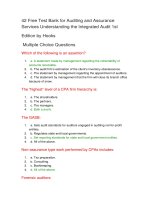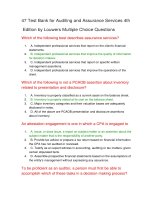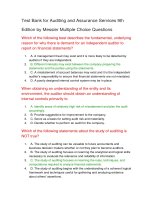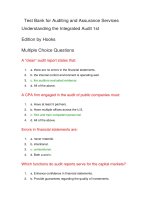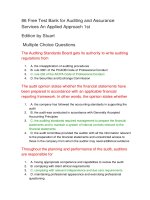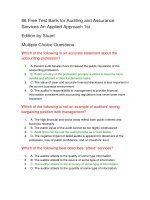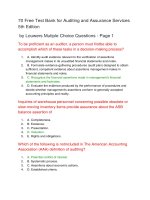Test bank for auditing and assurance services understanding the integrated audit 1st edition
Bạn đang xem bản rút gọn của tài liệu. Xem và tải ngay bản đầy đủ của tài liệu tại đây (75.51 KB, 15 trang )
Test Bank for Auditing and Assurance Services
Understanding the Integrated Audit 1st Edition
True - False Questions
If management has presented the actual economic events and
situation according to the accounting standards, then
there is a high degree of correspondence between the
underlying evidence and the resulting financial
statements.
1.
True
2.
False
Salaried partners of a CPA firm are compensated based on a
share in the firm’s profit.
1.
True
2.
False
Auditors consider and examine ICFR for all of the same
reasons, whether they are auditing a public or a nonpublic
company.
1.
True
2.
False
The SEC is responsible for setting standards for not-for-profit
organizations.
1.
True
2.
False
The Audit Committee of the Board of Directors performs the
audit and reports the results to shareholders and the
Board of Directors.
1.
True
2.
False
The organization of a typical CPA firm is similar to that of a
corporation.
1.
True
2.
False
CPAs who perform financial statement audits of public
companies are responsible for the accuracy of the client’s
financial statements.
1.
True
2.
False
Currently, the primary authoritative body that regulates
individual CPAs is the Congress of the United States.
1.
True
2.
False
Forensic accountants often investigate fraud.
1.
True
2.
False
The PCAOB was formed to meet one of the requirements in the
Sarbanes-Oxley Act of 2002.
1.
True
2.
False
The types of business structures used by CPA firms are
designed to make the professionals who own the firms
responsible for providing high quality services.
1.
True
2.
False
The Sarbanes-Oxley Act limits the amount of non-attest
services that auditors may perform for public companies
they audit.
1.
True
2.
False
The PCAOB jointly sets audit standards with the AICPA for
publicly traded firms.
1.
True
2.
False
An auditor’s report on an integrated audit will be unqualified if
internal control over financial reporting does not have any
material weaknesses and the financial statements are
fairly presented.
1.
True
2.
False
Because of regulatory requirements, a not-for-profit
organization’s audit report may be different from that of a
for-profit company.
1.
True
2.
False
An audit of a public company is referred to as an integrated
audit.
1.
True
2.
False
When there is a material misstatement in the financial
statements, the auditor requires management of the
company to correct the financial statements so the
auditor can issue an audit report.
1.
True
2.
False
In an ideal situation, internal auditors report to the Audit
Committee.
1.
True
2.
False
If a nonpublic company uses IFRS to prepare its financial
statements, it cannot receive an unqualified opinion when
audited using the AICPA Statements on Auditing
Standards.
1.
True
2.
False
CPAs who audit public companies may only perform attest
services.
1.
True
2.
False
Multiple Choice Questions
COSO:
1.
a. is the body that established an internal control standards framework referenced by
the PCAOB.
2.
b. published a document that explains what an internal control system should be like to
be effective.
3.
c. is the acronym widely used to refer to the Committee of Sponsoring Organizations of
the Treadway Commission.
4.
d. All of the above.
Who is responsible for oversight of the integrated audit
function?
1.
a. Shareholders.
2.
b. Officers of the company.
3.
c. The audit committee.
4.
d. None of the above.
The SEC requires publicly traded companies to file
1.
a. 10Ks that include audited quarterly financial statements and audited management
reports on internal control over financial reporting.
2.
b. 10Qs that include audited quarterly financial statements.
3.
c. 10Ks that include audited annual financial statements, with or without a management
report on ICFR.
4.
d. 10Ks that include annual financial statements, a management report on ICFR, and
the audit opinions resulting from an integrated audit.
Which of the following is an assertion?
1.
a. A statement made by management regarding the collectability of accounts
receivable.
2.
b. The audit firm’s estimation of the client’s inventory obsolescence.
3.
c. The statement by management regarding the appointment of auditors.
4.
d. The statement by management that the firm will close its branch office because of
snow.
Which of the following individuals could be a member of the
Audit Committee?
1.
a. A member of the company’s Board of Directors.
2.
b. A member of the PCAOB.
3.
c. An audit partner of the CPA firm who performs the annual audit.
4.
d. None of the above.
For an integrated audit to be possible:
1.
a. Established criteria must exist against which the financial statements and ICFR can
be compared.
2.
b. The auditor must have sufficient knowledge of both the AICPA SAS and PCAOB AS.
3.
c. The entity must have sufficient books, records and other underlying evidence so that
the auditor can determine whether there is a high degree of correspondence between
the underlying evidence and the financial statements.
4.
d. a and c
Assertions are:
1.
a. audited by the auditors.
2.
b. declarations made by management.
3.
c. declarations made by the auditor.
4.
d. Both a and b.
Financial statements must be prepared:
1.
a. in accordance with GAAP.
2.
b. in accordance with IFRS.
3.
c. in accordance with OCBOA.
4.
d. Any of the above, depending on which set of standards the circumstances dictate as
applicable.
To which of the following would AICPA attest standards not
apply?
1.
a. SSARs.
2.
b. Elder care.
3.
c. Loans under TALF.
4.
d. Internal control for a nonpublic company.
Forensic auditors:
1.
a. Investigate only fraud.
2.
b. Look for specific and detailed information.
3.
c. Perform engagements that can result in a standard, clean audit report.
4.
d. May not be CPAs.
What is the purpose of a financial statement audit?
1.
a. To provide assurance that the company is solvent.
2.
b. To provide assurance that the company has an effective internal control system that
can produce fair financial statements.
3.
c. To provide assurance that the financial statements are reliable.
4.
d. Both b and c.
The Securities and Exchange Commission:
1.
a. Is a government entity.
2.
b. Authorizes all PCAOB standards before they become effective.
3.
c. Can reject company filings or suspend trading of company stocks.
4.
d. All of the above.
The Board of Directors:
1.
a. Reports to management.
2.
b. Runs the company on a day-to-day basis.
3.
c. Is elected by the shareholders.
4.
d. All of the above.
A “clean” audit report states that:
1.
a. there are no errors in the financial statements.
2.
b. the internal control environment is operating well.
3.
c. the auditors evaluated evidence.
4.
d. All of the above.
Which of the following organizations is considered to be a
public company?
1.
a. A firm whose privately held stock is owned exclusively by an individual.
2.
b. A partnership of doctors.
3.
c. A privately-held firm controlled by three family members.
4.
d. A firm whose stock is registered with the SEC.
Errors in financial statements are:
1.
a. never material.
2.
b. intentional.
3.
c. unintentional.
4.
d. Both a and c.
The audit engagement team:
1.
a. is chosen by the client.
2.
b. is some combination of partners, managers, seniors and associates.
3.
c. is a mix of CPA firm and client employees.
4.
d. None of the above.
Auditors consider internal control during the audit of a
nonpublic company:
1.
a. For all the same purposes as on an audit of a public company.
2.
b. To identify areas of risk and help to plan the financial statement audit.
3.
c. To help to plan the financial statement audit and issue an opinion on effectiveness.
4.
d. Only if they are sure it will be helpful when performing the financial statement audit.
The audit report states that the audit provides:
1.
a. a guarantee of quality.
2.
b. complete assurance that the financial statements are free from misstatements.
3.
c. absolute assurance that the internal control environment is operating effectively.
4.
d. None of the above.
Regarding the PCAOB, which of the following is INCORRECT?
The PCAOB:
1.
a. Is responsible for oversight of audit firms engaged in the audit of public companies.
2.
b. Issues standards that govern audits of public companies.
3.
c. Is a not-for-profit entity.
4.
d. Has authority that is equal in power to the SEC.
Which of the following best describes the conclusions an
auditor makes in an integrated audit that results in an
audit report that is unqualified?
1.
a. The financial statements are fair according to GAAP.
2.
b. The financial statements are free of material misstatement based on U.S. GAAP and
management’s report on internal control over financial reporting states that there are no
material weaknesses.
3.
c. The financial statements and internal control over financial reporting are materially
correct.
4.
d. The financial statements are free of material misstatement based on U.S. GAAP and
based on the audit, the auditor agrees with management’s report that internal control
over financial reporting is effective and does not have any material weaknesses.
Shareholders use audit reports to monitor management
performance. An example of an item that an audit report
does NOT provide is:
1.
a. Reasonable assurance on reported information that might be used to provide
justification for management’s performance-based compensation.
2.
b. Access to foreign markets.
3.
c. An indication of whether or not a company has major problems in its internal control
over financial reporting.
4.
d. Feedback on any ICFR material weaknesses that management may choose to use
to improve operational or financial efficiency.
Auditing is defined as a:
1.
a. set pattern of tests.
2.
b. random process.
3.
c. systematic process.
4.
d. All of the above.
Who is responsible for the design and operation of ICFR?
1.
a. The auditor.
2.
b. The company’s management.
3.
c. Both a and b.
4.
d. None of the above.
The AICPA (American Institute of Certified Public Accountants):
1.
a. Is regulated by Congress.
2.
b. Reports to the PCAOB.
3.
c. Regulates CPAs at the state level.
4.
d. None of the above.
Auditors communicate audit results to users concerning a
company’s financial statements by:
1.
a. issuing a report on the effectiveness of ICFR.
2.
b. issuing the financial statements.
3.
c. issuing a report about the financial statements.
4.
d. None of the above.
The value of an integrated audit
1.
a. Is limited to its effects on the capital markets since integrated audits are conducted
only for publicly traded companies.
2.
b. Extends to various groups and probably is different for the different people and
entities.
3.
c. Is exactly the same as the value generated by a financial statement audit of a
nonpublic company.
4.
d. None of the above are correct.
Internal auditors may not perform:
1.
a. Audits of financial statements resulting in reports intended for management’s use
only.
2.
b. Forensic audits.
3.
c. Integrated audits leading to an audit opinion issued in accordance with AICPA or
PCAOB standards.
4.
d. All of the above.
The GASB:
1.
a. Sets audit standards for auditors engaged in auditing not-for-profit entities.
2.
b. Regulates state and local governments.
3.
c. Set reporting standards for state and local government entities.
4.
d. All of the above.
Which body regulates the audits of nonpublic companies in the
United States?
1.
a. PCAOB
2.
b. AICPA
3.
c. IFRS
4.
d. SEC
Which functions do audit reports serve for the capital markets?
1.
a. Enhance confidence in financial statements.
2.
b. Provide guarantees regarding the quality of investments.
3.
c. Provide assurance that financial statements and management’s reports on internal
control over financial reporting provide reliable information.
4.
d. Both a and c
The auditor:
1.
a. prepares the financial statements after the client agrees to all adjustments.
2.
b. writes the footnotes to the financial statements to ensure their accuracy.
3.
c. performs work to reach an opinion on the ICFR and financial statements.
4.
d. None of the above.
An integrated audit results in:
1.
a. an audit opinion on the financial statements.
2.
b. an audit opinion on ICFR.
3.
c. a series of reports to major stakeholders.
4.
d. Both a and b.
Which of the following is a current responsibility of the AICPA?
1.
a. Writing and grading the CPA exam that is used by the states.
2.
b. Issuing CPA certificates.
3.
c. Setting international audit standards for nonpublic companies.
4.
d. Writing the code of conduct that is adopted by all of the states.
A public company must:
1.
a. register with the SEC.
2.
b. undergo an integrated audit.
3.
c. trade on a stock exchange.
4.
d. Both a and b.
Which of the following is NOT a “Big Four” firm?
1.
a. PwC.
2.
b. Grant-Thornton.
3.
c. Deloitte & Touche.
4.
d. Ernst & Young
Which of the following would not be considered audit
evidence?
1.
a. Invoices received by the company and retained on the company’s IT system in
electronic form.
2.
b. The electronic work paper program package used by the auditor to produce the
electronic work papers.
3.
c. Hard copy minutes of the Board of Directors and Audit Committee meetings.
4.
d. Electronic images of the front and back of checks that the company has written.
Non-assurance type work performed by CPAs includes:
1.
a. Tax preparation.
2.
b. Consulting.
3.
c. Bookkeeping.
4.
d. All of the above.
A non-equity partner likely:
1.
a. Shares in all of the work for the firm.
2.
b. Is compensated by sharing in the profits of the firm.
3.
c. Has partner responsibility for work performed.
4.
d. All of the above.
The audit engagement team consists of:
1.
a. more than one partner.
2.
b. associates and seniors.
3.
c. managers.
4.
d. All of the above.
A CPA firm engaged in the audit of public companies must:
1.
a. Have at least 5 partners.
2.
b. Have multiple offices across the U.S.
3.
c. Hire and train competent personnel.
4.
d. All of the above.
The “highest” level of a CPA firm hierarchy is:
1.
a. The shareholders.
2.
b. The partners.
3.
c. The managers.
4.
d. Both a and b.
